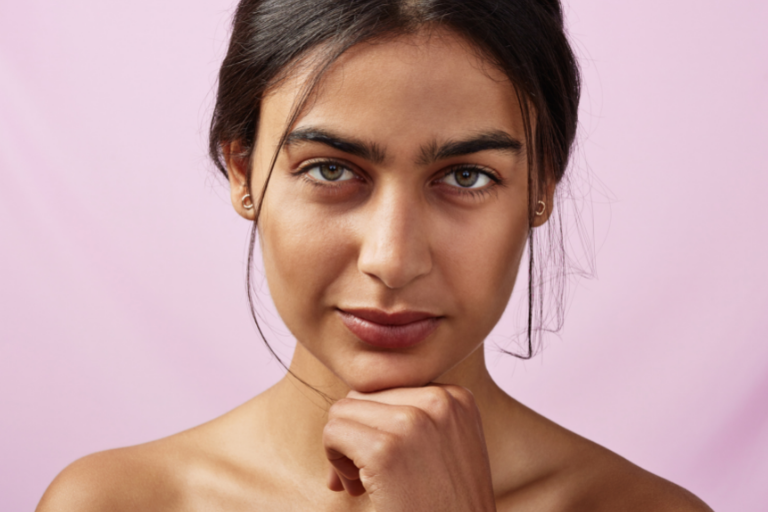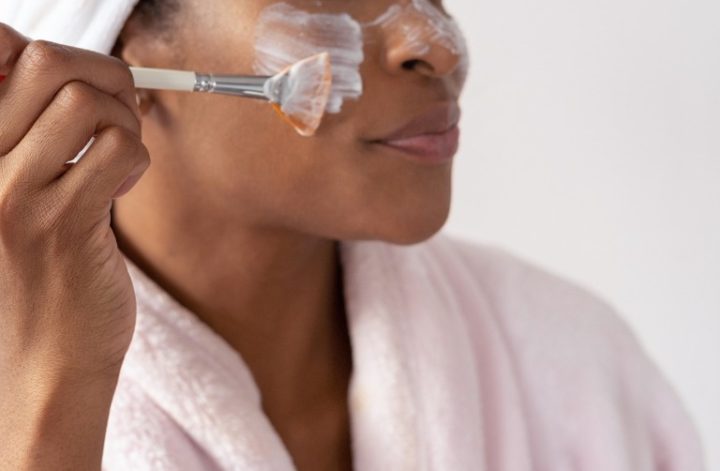
You’ve been hearing about “clean beauty” for a while now, and you’re finally ready to give it a try! Or maybe you’ve had a clean beauty routine for ages, but you’re on the hunt for new brands and products to build your skincare routine.
Either way, I can’t wait to share with you my non-toxic skincare routine that helps me achieve glowing skin! After reading this post, you’ll have learned a clean, cruelty-free skin care routine to help you get the glowy skin you’ve been dreaming of, while using planet-friendly products you can feel good about!
This post has been updated as of January 24, 2023. My skincare routine has completely changed, even though I kept to my standards for non-toxic and cruelty-free skincare products! Enjoy 🙂
Note: You’re about to see a lot of nontoxic skincare products from InnBeauty Project. While this post contains affiliate links, this blog post is not sponsored by them in any way, and I can tell you I paid for every product myself (unless it was a Christmas present from a loved one).
This post contains affiliate links. This doesn’t cost you anything, but I may make a commission payment from anything you buy through these links. As an Amazon Associate I earn from qualifying purchases at no extra cost to you. All opinions remain my own. Thank you for supporting Of Good Report!
What even is clean beauty and clean skincare?
To take a direct quote from this article, “Safe for people and the planet, clean means that a beauty product should have considered human and environmental health, using a nontoxic element as a baseline and plant-based ingredients for active results.”
Basically, clean beauty is good for you, good for the environment, and doesn’t contain toxic ingredients that have been linked to cancer or other major health concerns.
However, there is no hard definition of what makes a product “clean.” It’ll vary from person to person and brand to brand. Because all the details can get overwhelming, I like to combine lists like Sephora’s and Target’s guidelines for what they consider “clean” products with a few of my own preferences.
So, the clean skincare products I mention in this post will be free of:
- Parabens
- Sulfates SLS and SLES
- Phthalates
- Synthetic fragrance
- Siloxanes
- Mineral oils
- Retinyl palmitate
- Oxybenzone
- Coal tar
- Hydroquinone
- Triclosan
- Triclocarban
- Animal products
- Talc
- Formaldehyde
- Formaldehyde releasers (Bronopol, DMDM hydantoin, diazolidinyl urea, imidazolidinyl urea, and quaternium-15)
- Triclosan
- Silica
- Refined petroleum
Always do your research to see what works for you personally, as everyone will have different preferences with what they’re comfortable with. 🙂
What’s the difference between clean beauty, natural beauty, and organic beauty?
I’m not a dermatologist, but I’ve done my research to help simplify these confusing terms. If you’re wondering the difference between clean skincare, natural skincare and organic skincare, here’s the gist.
Clean skincare
“Clean beauty”or “clean skincare” includes a wide spectrum of beauty products and brands. The term itself is not super highly regulated, so there are differences here and there.
But in a nutshell, clean skincare’s primary characteristics are that the products don’t contain any toxic elements, and are safe for both you the consumer and the environment.
Keep in mind that clean skincare can be natural and organic, but it doesn’t have to be. A product can be clean even if it contains synthetic materials, so long as there isn’t anything harmful in the formula.
Natural skincare
“Natural beauty” or “natural skincare,” like “clean” isn’t a rigid definition, so unfortunately that leaves a good deal of detective work to the consumer.
While some products or brands might be marketed as “natural,” that can mean anything from “this product contains only natural ingredients,” to “this product contains natural ingredients, along with a bunch of harsh, synthetic ingredients as well.”
So, you’ll want to scan the ingredients to see just how natural the product actually is. Another major point is that natural ingredients aren’t always better for your skin, and synthetic ingredients aren’t necessarily bad.
For example, essential oils like citrus oils, which are natural, are a common skin irritant for those with sensitive skin.
Organic skincare
And finally, “organic beauty” or “organic skincare” means that the product contains ingredients grown without chemical fertilizers, growth hormones or genetic mutations.
Basically, it means the same thing as the “organic” labels on food.
However, it’s important to note that a company can market their products as “organic” without being “organic-certified.” If the label only reads “organic,” you should read the ingredients because that can mean the product contains mostly organic ingredients, or it could mean it contains a teeny bit of organic ingredients and a bunch of other stuff.
Why should you switch to clean beauty?
To sum it up, clean beauty matters because you want to know that the product you’re wearing on your skin all day long isn’t made up of toxic ingredients that are potentially harmful to your skin, your health, OR the environment.
One of my favorite businesswomen/blogger/podcasters, Jenna Kutcher, talks about her journey with infertility and how she learned that her skincare and beauty products–even her deodorant–were negatively impacting her fertility.
I don’t know if I ever want kids or not, but I want to give myself the option.
So overall, the benefits of switching to clean beauty are:
- It reduces your exposure to toxic ingredients;
- It’s good for sensitive skin;
- Eco-friendly;
- Sustainable;
- Cruelty-free;
- Shouldn’t affect fertility or hormones.
How expensive is clean beauty and clean skincare?
So of course, one of the first things that stops people from switching to clean beauty is they assume it must be much more expensive than regular drugstore prices. But, how much more expensive is clean skincare? The answer: It depends!
There are definitely some pricey clean beauty and clean skincare brands out there. Drunk Elephant, SuperGoop, Farmacy, and Herbivore are some cult favorites with higher price tags.
But clean beauty is usually going to be at least a little more pricey because it contains higher quality ingredients. When companies take the easy way out by using cheaper and toxic ingredients, they can afford to price their products lower.
But that doesn’t mean clean beauty is off the shelf for you if you’re on a budget!
Affordable, cleaner skincare brands
Target “Clean” brands are one of my favorite ways to shop for affordable, cleaner beauty and skincare products. Target clean brands are cruelty-free, generally affordable and according to their website are free of:
- Propyl-parabens,
- Butyl-parabens,
- Phthalates,
- Formaldehyde,
- Oxybenzone,
- SLES,
- Retinyl palmitate,
- BHA & BHT,
- And a bunch of other stuff.
You can shop Target’s clean skincare brands here! (always check ingredients to be sure the products match your standard for “clean!”):
However, my very favorite of all time skincare brand for non-toxic, cruelty-free beauty is InnBeauty Project. You can shop directly from their site, or catch them at Sephora!
And now, we’re finally ready to jump into my clean skincare routine for glowing skin!
My daily clean beauty skincare routine for glowing skin
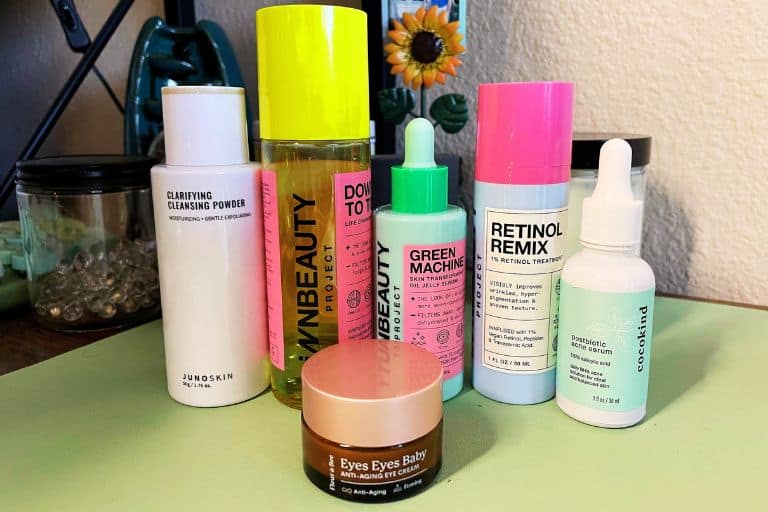
This post contains affiliate links. This doesn’t cost you anything, but I may make a commission payment from anything you buy through these links. As an Amazon Associate I earn from qualifying purchases at no extra cost to you. All opinions remain my own. Thank you for supporting Of Good Report!
Although this post contains affiliate links, this blog post is not in any way sponsored by InnBeauty Project or any of the other nontoxic skincare brands mentioned. I just really freaking love these products and genuinely own and use each of them daily or weekly.
Step 1: Cleanse and double cleanse
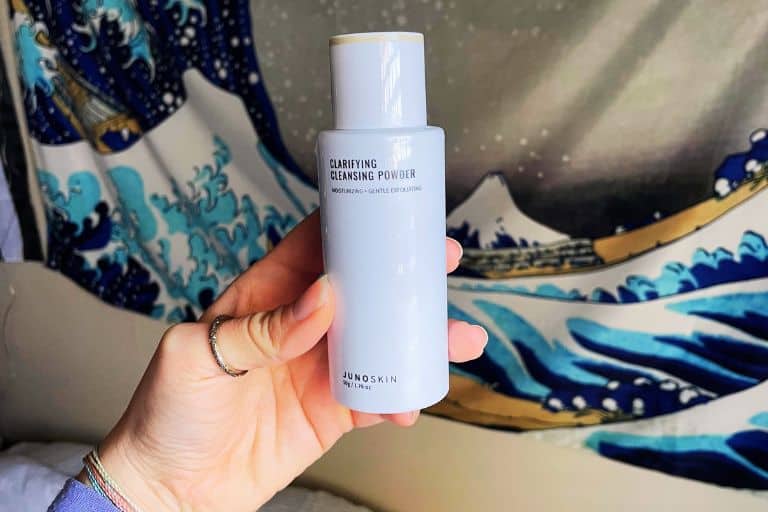
Double-cleansing is really useful for getting alllll the icky stuff off your skin and out of your pores.
Currently I do my first cleanse with the Junoco cleansing bar, but since it’s been discontinued you can use whatever cleanser you fancy.
Then, I double cleanse with the Junoco Clarifying Cleanser Powder. I looove this cleansing powder because it has anti-aging properties and evens out my skin tone. Plus, the powdered formula acts as a physical and chemical revitalizer for my skin, thanks to the rice powder derived from Japanese Sake.
Pour this cleansing powder into wet hands and rub together until it creates a foam, then wash your face like usual. A little goes a long way. I’ve had this powdered cleanser for about two months, use it about twice a day, and I’ve still got plenty left.
Besides the regular benefits of double cleansing–like removing all the oil, makeup, dirt, and sebum buildup– the Junoco cleanser hydrates and strengthens your skin’s barrier, while simultaneously softening your skin thanks to antioxidant-rich rice lees extract.
Secondly, the papaya enzyme exfoliates dead skin cells to help your skin glow.
And to top it off, the formula includes hyaluronic acid for extra hydration.
Step 2 (PM only): Tone face with InnBeauty Project’s professional-grade toner
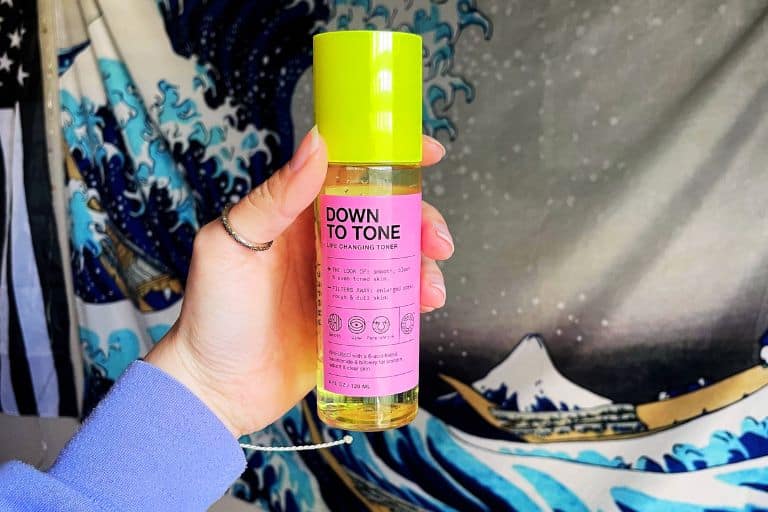
I alternate the nights I use the Down to Tone toner (an AHA and BHA resurfacing treatment) with the nights I use my 1% retinol treatment. Because they’re both very powerful, I don’t like to use this toner on the same night as the retinol, but I’ll get to that step in a moment.
This toner is amazing and has shown dramatic improvements–for other customers and for myself. The main points of this toner are to improve the look of hyperpigmentation, large pores and rough texture, while also minimizing fine lines.
I apply the toner to a cotton pad and dab it on my face (don’t rub!), avoiding my eyes and mouth areas. Because it’s so potent, I tend to flush and turn red for several minutes, but my skin calms down eventually.
Besides using this toner in the evening, I don’t use a toner in the morning anymore–I just felt like it wasn’t really needed for my skin.
Step 3: Dab on anti-aging eye cream
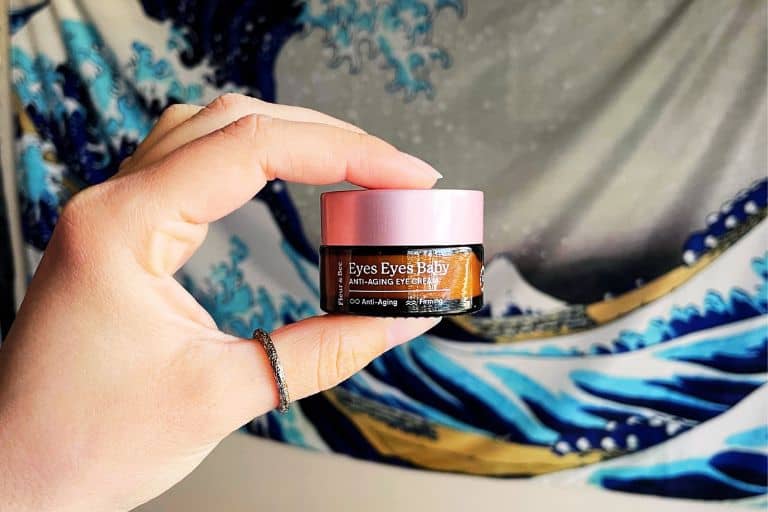
Update: When I first wrote this post in 2021, a jar of Fleur & Bee eye cream was $22. Today, it’s $36. So, definitely a big price leap, which is obviously not ideal. However, because I’m still in love with my results, I’m still dishing my cash out to them haha.
The Eyes Eyes Baby brightening eye cream is one of the first products I received from Kinder Beauty Box. It’s a natural, anti-aging eye cream that I’ve found to be really effective.
(If you love non-toxic beauty products and are ready to look for some new cruelty-free beauty brands, read my full Kinder Beauty Box review to see if this beauty box is a good fit for you!)
First of all, it really helped soften the crows’ feet around my eyes, as well as helped lighten the dark circles.
I also had some crinkly looking skin under my eyes due to me always squinting (I used to never wear sunglasses), and those crinkles are way less obvious now.
Like a lot of eye creams, this one contains caffeine. But it also has Vitamin B3 (Niacinamide), a natural peptide that reduces wrinkles (called matrixyl 3000), and Vitamin E and squalene.
All of these ingredients, plus some extra fun ones like organic Green Tea Extract make this eye cream incredibly effective at brightening and smoothing fine lines.
Step 4: Apply serum AM/PM
After cleansing, toner and eye cream, I always follow up with a serum. Since I have two serums that I alternate between, I’ll dive into them separately.
My serums alternate depending on what I feel my skin needs or other products I put on the night before, but I typically use Green Machine (which has Vitamin C) the morning after retinol or after using Down to Tone in the PM.
My other go-to serum is Cocokind’s Postbiotic Acne serum (1.5% salicylic acid) the morning after using my toner.
Using the Green Machine Serum
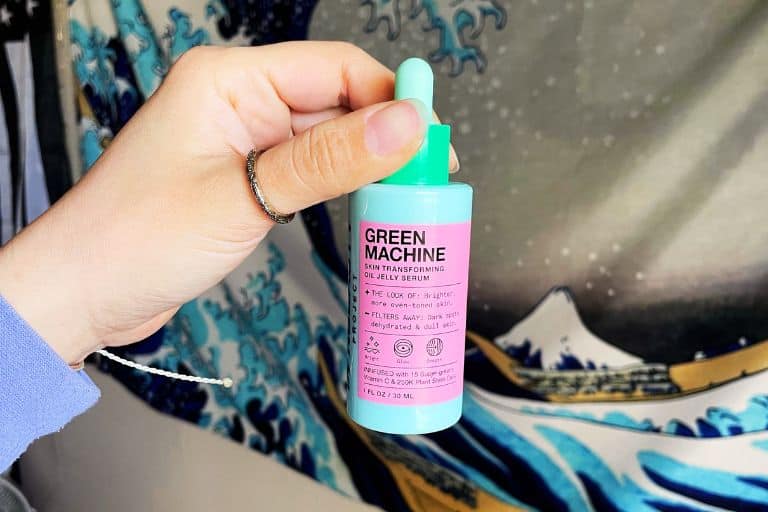
This serum is packed full of amazing ingredients–including 250 thousand plant stem cells to increase firmness and reduce wrinkles, 15 Super Foods for tons of nourishment, azelaic acid to reduce hyperpigmentation, and 1% Vitamin C for brightness and to decrease fine lines.
I’m in love with this serum for its ability to improve my dark spots from acne, uneven texture, and hyperpigmentation. And since I’m nearing my 30s (okaywowthatsactuallycrazy), I love anything that helps me fight fine lines.
I use the Green Machine as a third step on nights when I apply Down to Tone toner, and after cleansing in the mornings if I used retinol the night before. Since Green Machine contains Vitamin C, I never use it at the same time as retinol because it can cause irritation.
Using the Postbiotic Acne Serum
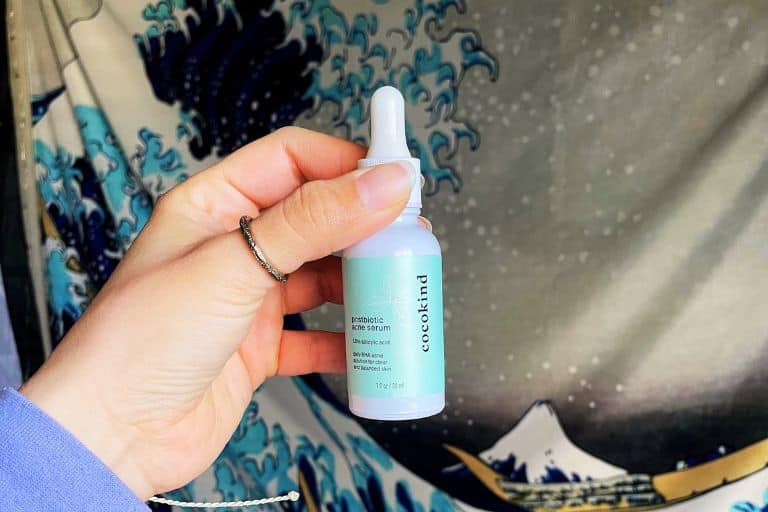
And my second, all-time favorite serum is Cocokind postbiotic acne serum (formerly known as the probiotic acne serum).
I hesitate to credit clear skin to a single product, but I have to admit that this serum has been a game-changer for me. Literally nothing else has kept my breakouts at bay to the same degree as this serum. Once, I took a break from using it and my breakouts started coming back, so I immediately re-purchased it.
I use this serum as a second step after cleansing in the mornings, usually after using Down to Tone the night before.
Step 5: Moisturize both day and night
AM Moisturizer: SLUSHY Serum Moisturizer
I’ve bought at least four bottles of this serum-moisturizer hybrid, and I will probably continue buying it til the day I die.
It’s insanely hydrating, and gives my skin a visible difference in my skin’s plumpness and texture. It’s infused with bakuchiol and hyaluronic acid, and always leaves my skin looking dewy and super smooth.
I use this moisturizer in the daytime because it’s so lightweight. The only time I don’t use it in the mornings is if it’s winter and my skin is much more dry than usual. If my skin is overly dry, I’ll usually opt for my PM moisturizer.
PM Moisturizer: 10 + 10 Daily Moisturizer

My faaaaavorite moisturizer of all time is the 10+10 Daily Moisturize from InnBeauty.
I use this every night because it’s so soothing, doesn’t leave my skin feeling oily or greasy at all, and the 10% Vitamin C and 10% Peptide formula makes my skin look super radiant and glowing the next day.
The longer I use it, the better my skin texture looks overall.
Like I mentioned before, I’ll use this moisturizer every night, and in the mornings during winter months as well, for extra hydration.
Step 6: Finish with a non-toxic sunscreen
The final step to any skincare routine, clean or otherwise, is of course sunscreen. To maintain glowing, youthful skin as long as possible, sunscreen is a must!
My favorite mineral sunscreen is Cocokind mineral-based Daily SPF. It has a really nice glowy finish, doesn’t leave my skin feeling greasy or sticky, and–with my skin tone–it doesn’t leave a white cast.
However, some people with darker skin tones have reported a white cast with the Daily SPF, so Cocokind launched Silk SPF, which is a chemical and mineral hybrid sunscreen specifically created to leave no white cast on any skin tone.
My second favorite mineral sunscreen is Native Coconut and Pineapple face sunscreen. It’s free of oxybenzone and octinoxate, and is compliant with Hawaii’s ingredient requirements for sunscreen.
I always try to buy sunscreens that are considered “reef-safe,” although reef-safe isn’t a regulated term (just like the terms “clean” or “non-toxic.”)
To keep the reefs safe to the best of my abilities, I try to avoid sunscreens with ingredients such as oxybenzone and octinoxate, as they have the potential to be environmentally hazardous.
Why UVA and UVB rays are dangerous to your skin
UVA rays are the sun rays that give you tans and sunburns. But they also cause aging and can lead to skin cancer because they penetrate deep into your skin. The craziest thing about UVA rays is that they’re present constantly during daylight. So, even if it’s cloudy or overcast and the sun’s not out, UVA rays are present. You can’t see or feel them.
They even penetrate through windows, which is why you should wear sunscreen even if you’re just driving to work every day. Those UVA rays are still making their way through the windows of your car and the windows at your office, into your skin.
UVB rays, on the other hand, don’t go as deep into your skin and can’t penetrate through windows or glass. However, UVB rays are still dangerous and are the cause of sunburns and discoloration on the skin, like dark spots. They also play a role in skin cancer, though not as much as UVA rays.
Ingredients to look for in clean sunscreen
For sunscreen to be “clean” it should not contain:
- retinyl palmitate
- avobenzone
- oxybenzone
- octinoxate
Retinyl palmitate is a form of Vitamin A, and while that’s usually a bonus, this form has been suggested to react poorly with the sun. It’s been shown to create free radicals, so of course that’s the opposite of what you want in a sunscreen.
This article highlights the issues with both oxybenzone and octinoxate, which include but aren’t limited to:
- Lower testosterone in males (specifically in children)
- Causes other hormonal issues
- Might increase risk of breast cancer
- Bad for ocean life, especially the coral reef
Finally, avobenzone is a skin irritant and isn’t sun-stable. So basically, it has to be mixed with stabilizers like Octisalate, which has some toxicity concerns.
When shopping for a clean sunscreen, you want a broad spectrum mineral sunscreen made with titanium dioxide or zinc oxide. Also, look for one that’s branded as being “reef safe,” so you know it shouldn’t be harmful to aquatic life.
You can shop my favorite clean sunscreen brands below! They’re free of retinyl palmitate, avobenzone, oxybenzone, octinoxate!
Conclusion to the non-toxic skincare routine for glowing skin
There you have it, lovely! My six step clean skincare routine to get the glowing skin of your dreams. It’s taken me a while to really take my skin care seriously, but now that I have, I’ll never slack on it again. There’s just something so reassuring about knowing you love your skin the way it is, and knowing that the products you’re putting on it aren’t harmful to your health or the planet.
If you found this post helpful or inspiring, I’d super appreciate if you shared it using the buttons just to your left 🙂
Got questions about your skincare or other beauty questions? Or just want to chat? Feel free to drop a comment, send me an email to hello@savduffy.com or follow me on Insta!
Til next time, ya hot tamale.



